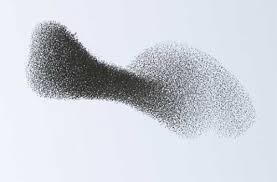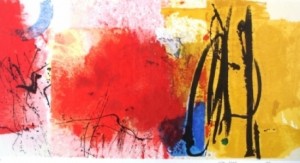
In the course of the years I have developed a workshop combining my understanding of complex systems and art. It has been widely recognized in anthropology, biology, physics and computer science that living systems are governed by simple rules. Like in a flock of birds: fly to the centre, keep the same pace and don’t bump into each other. These rules enable the individual birds to survive and travel long distance as part of a living system. In art my dear friend and artist, the late Peter Schenk, taught his students some rules for creating balance and dynamics in a painting. The rules I mention in the workshop are derived from Peter’s teachings. Below they are illustrated by some examples from his work.
Creating a painting; Simple Rule#1: Colour does not follow lines
We have all been taught at school to draw within the lines. For a six year old that is a great challenge. I was never worried about this concept before: Pot of paint, hands, paper, that was all: freedom. But then things became serious. I remember this girl in my class won a prize for keeping the colours within the lines, where I found myself struggling with my restless hands and eyes to keep my pencils under control.
Creating a painting: Simple Rule #2: Layers create meaning
Layers transfer the richness of three dimensionality on a plane. Like in story, multiple storylines engage your attention. Art historian Gombrich writes how our eyes never stop looking for patterns. Layer upon layer of paper lend a lyrical quality to the work.

Creating a painting; Simple Rule#3: Less is more
True for most things, but especially in art. ‘In der Beschränkung zeigt sich der Meister’ said Goethe. Peter said just before he passed away: ‘to stop is the hardest thing’. He meant both: leaving a painting alone and leave life, alone.
Creating a painting; Simple Rule#4: Two structures and a distinctive voice
Peter studied Haiku’s. He discovered a rule for balance from the thesis, antithesis, synthesis principle of the early Japanese poets. There are basically two structures: The blue squares and the angular buff on grey background are the same and yet different. These stuctures and each others complemetary opposites. They are brought together by the distinctive voice of the golden leaf shape that echoes elsewhere in the painting.
What are the rules in the systems you live in? Do you find you can change them? Are there productive and inproductive rules?
I am deeply endebted to Peter Schenk for his guidance, his inspirations and his friendship. The images in this blog are found on Peter Schenk’s site.



Leave a Reply